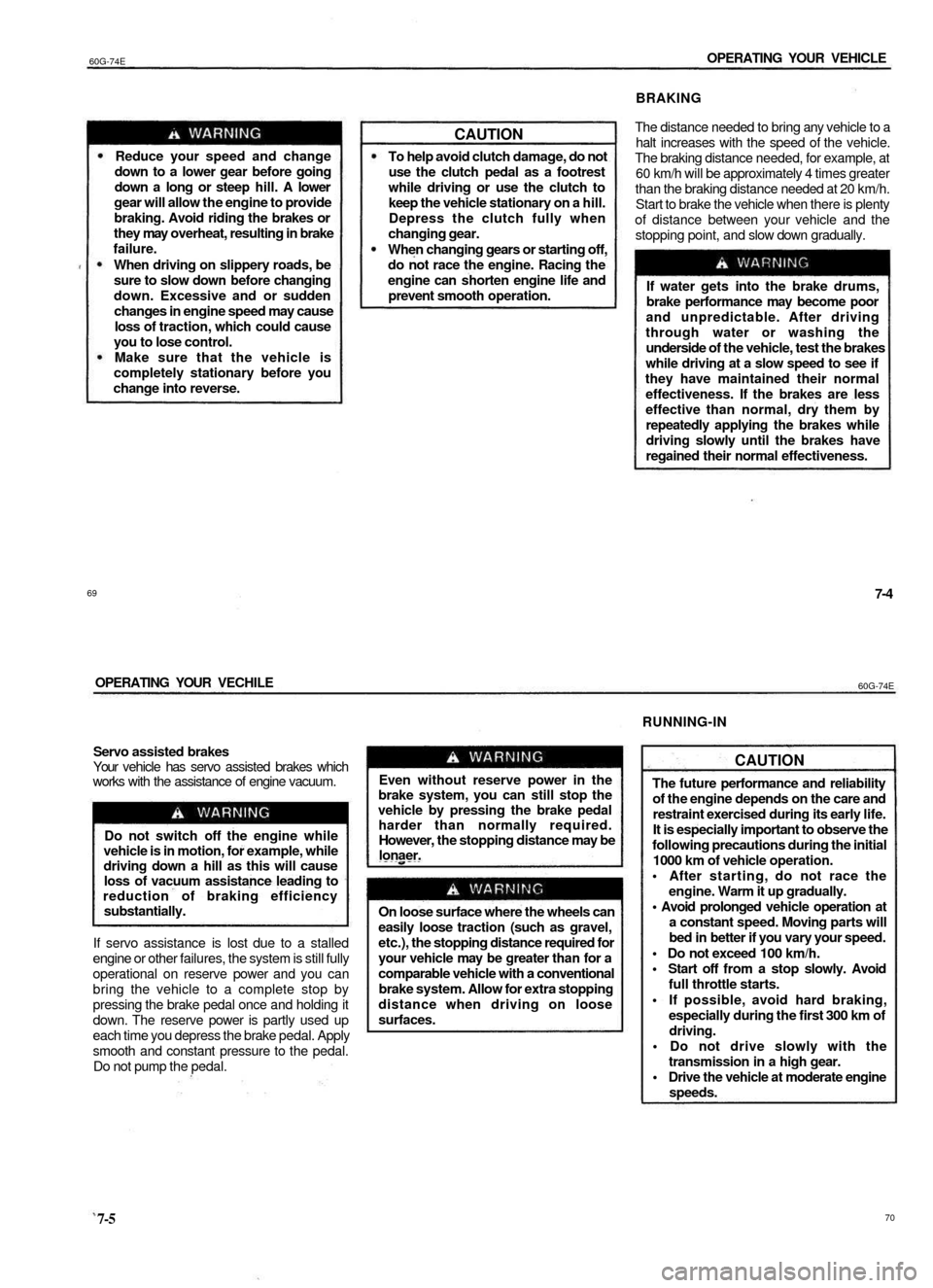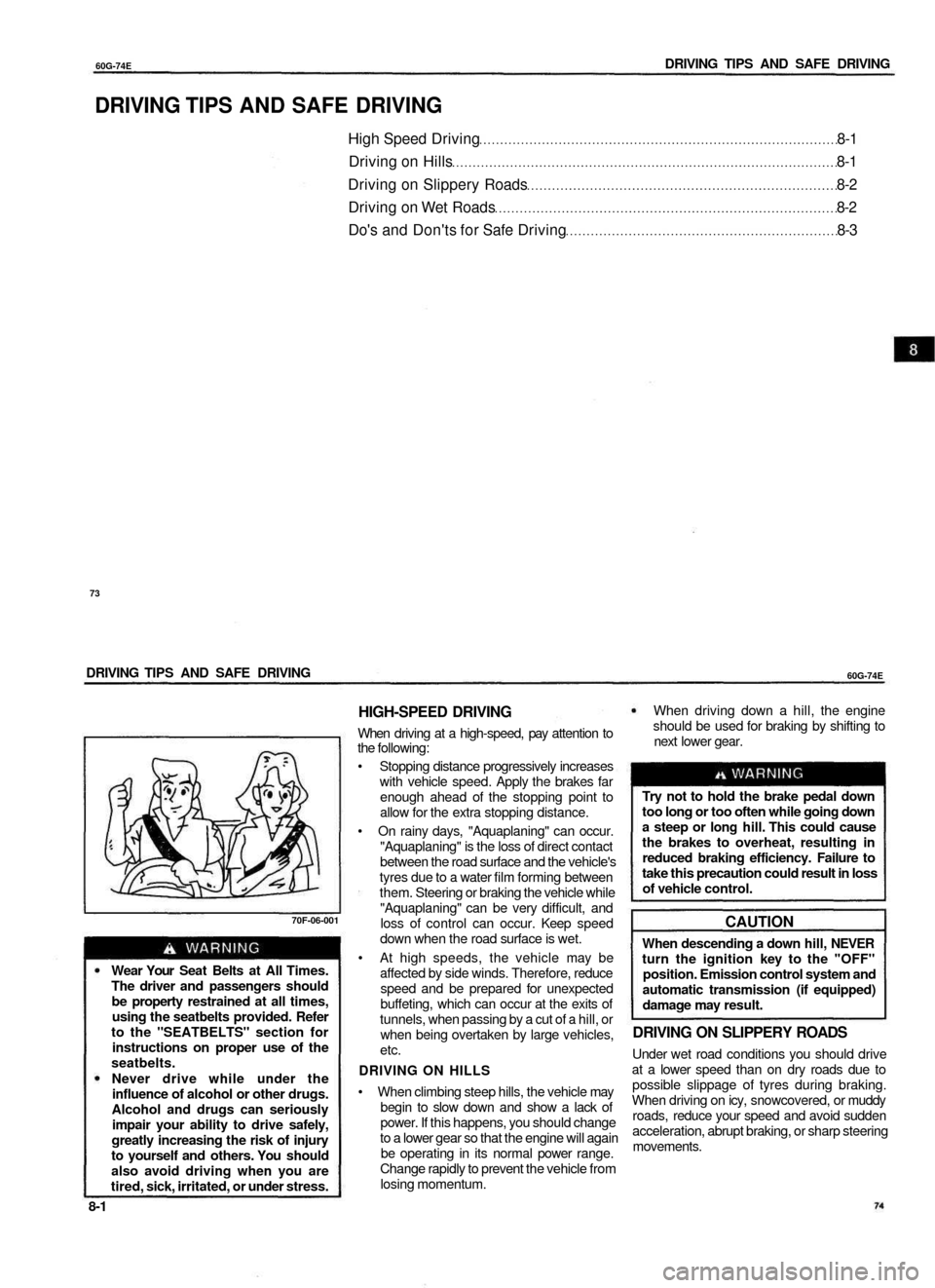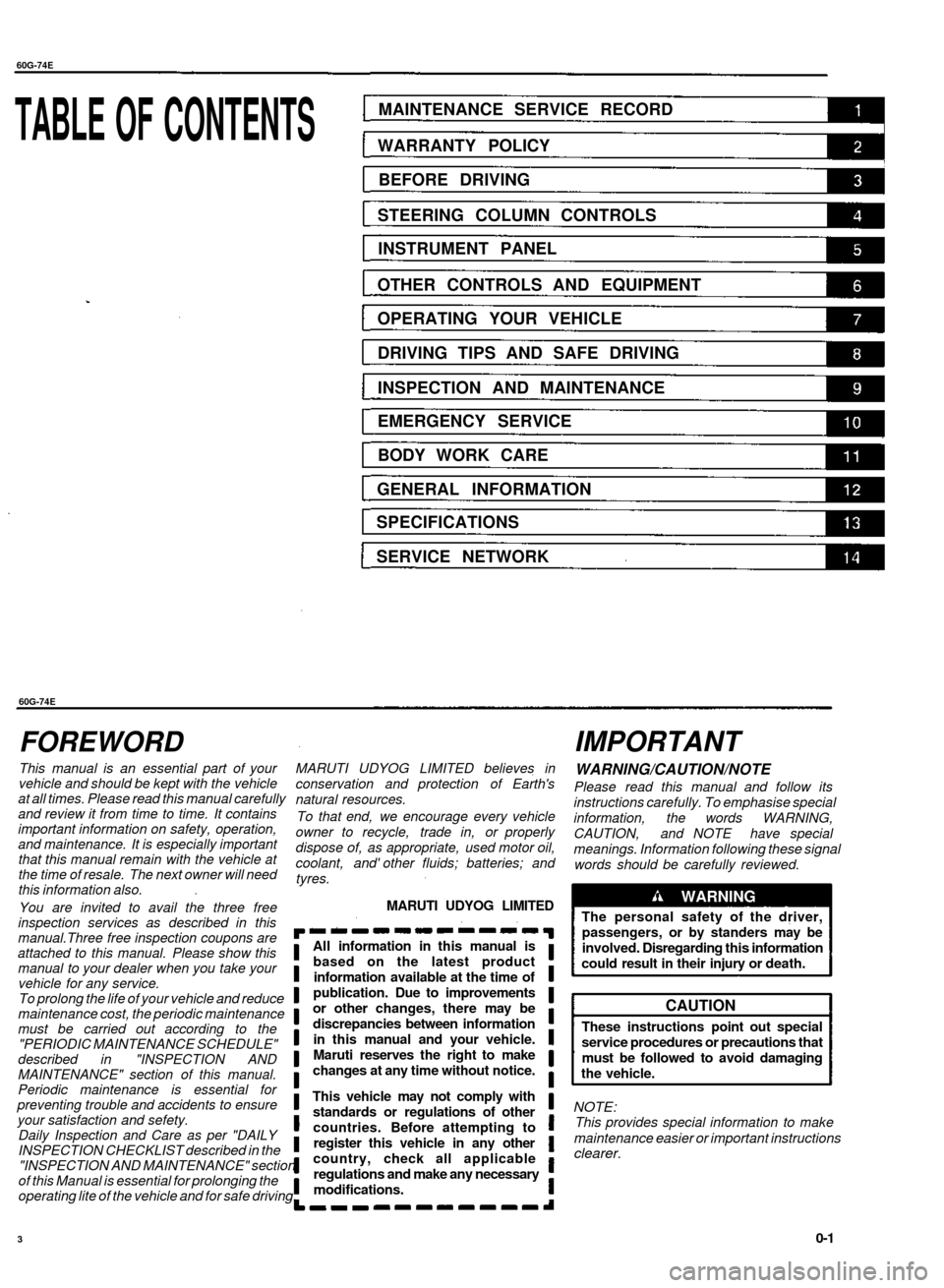1999 SUZUKI BALENO change time
[x] Cancel search: change timePage 30 of 65

OTHER CONTROLS AND EQUIPMENTS
60G-74E
CUP HOLDER (if equipped)
TYRE CHANGING TOOLS
60G-06-007
3)
Continue to lift up the bonnet until it is high
enough to support with the prop rod.
Make sure the bonnet Is fully closed
and latched before driving. If it is not,
it can fly up unexpectedly during
driving, obstructing your view and
resulting in an accident.
60G-06-008
To use the cup holder, pull it out fully. After
using the holder, push it back in.
Do not use the cup holder to hold cups
containing hot liquids, or objects other
than cups. Objects in the cup holder
may be thrown about during a sudden
stop or impact, and could cause
personal injury.
60G-06-009
The jack, wheel wrench and jack crank are
stowed in the luggage compartment behind
the rear seat.
To remove the jack, turn its shaft
counterclockwise and pull the jack out of the
storage bracket. To stow the jack, place it in
the storage bracket and turn the shaft
clockwise until the jack is securely held in
place.
6-7
60
60G-74E
OTHER CONTROLS AND EQUIPMENT
LUGGAGE COMPARTMENT TRIM TRUNK (BOOT) LIGHT (if equipped)
Luggage or other cargo placed in the luggage
compartment are hidden from view by a
luggage compartment trim.
Do not carry items on top of the
luggage compartment trim, even if they
are small and light. Objects on top of
the trim could be thrown about In an
accident, causing injury, or could
obstruct the driver's rear view.
60G-06-010
6OG-O6-O11
The jack should be used only to change
wheels. It is important to read the
jacking Instructions in the
EMERGENCY SERVICE section of this
manual before attempting to use the
jack.
When you open the trunk (boot) lid, the trunk
(boot) light comes on and remains on as
long as you keep the lid open.
Do not leave the boot (trunk) lid open
for a long time, or the battery will
discharge.
After using the jack, jack crank and
wheel wrench, be sure to stow them
securely or they can cause injury if an
accident occurs.
61
6-8
Page 33 of 65

60G-74E
OPERATING YOUR VEHICLE
Once a week, or each time you fill your fuel
tank, perform the following under-bonnet
checks:
1) Engine oil level.
2) Coolant level.
3) Brake fluid level.
4) Power steering (if equipped) fluid level.
5) Windscreen washer fluid level.
6) Battery solution level.
7) Bonnet latch operation.
Pull the bonnet release handle inside the
vehicle. Make sure that you can not open
the hood all the way without releasing the
secondary latch. Be sure to close the hood
securely after checking for proper
operation. See "All Latches, Hinges &
Locks" of "PERIODIC MAINTENANCE
SCHEDULE" in the "INSPECTION AND
MAINTENANCE" section for lubrication
schedule.
Make sure the bonnet is fully closed
and latched before driving. If it is not,
it can fly up unexpectedly during
driving, obstructing your view and
resulting in an accident.
STARTING THE ENGINE
Before starting the engine:
1) Make sure the parking brake is applied
fully.
2) Manual Transmission - Shift into "N"
(neutral) and depress the clutch pedal all
the way to the floor. Hold it while starting
the engine.
Make sure that the parking brake is
applied fully and the transmission is in
Neutral before attempting to start the
engine.
CAUTION
Stop turning the starter immediately
after the engine has started or the
starter system can be damaged.
Do not crank the engine for more
than 15 seconds at a time. If the
engine doesn't start on the first try,
wait about 15 seconds before trying
again.
Starting a Cold Engine
Engine which is started after 6 hours should
be treated as cold engine.
For Electronic fuel injection models
• With your foot off the accelerator pedal,
crank the engine by turning the ignition
key to "START1. Release the key when the
engine starts.
• If the engine does not start after 15
seconds of cranking, wait about 15
seconds, then press down the accelerator
pedal to 1/3 of its travel and try cranking
the engine again. Release the key and
accelerator pedal when the engine starts.
• If the engine still does not start, try holding
the accelerator pedal all the way to the
floor while cranking. This should clear the
engine if it is flooded.
Starting a Warm Engine
For Electronic fuel injection models:
Use the same procedure as for "Starting a cold
Engine".
67
7-2
OPERATING YOUR VECHILE
60G-74E
USING THE TRANSMISSION
70F-04-005E
Starting off
To start off, depress and maintain pressure
upon the clutch pedal and change into 1st
gear. After releasing the parking brake,
gradually release the clutch. When you hear
a change in the engine's sound (speed), gently
apply pressure to the accelerator to keep the
engine sound (speed) constant whilst
continuing to gradually release the clutch.
Gear changing
All forward gears are synchronized, which
provides for quiet, easy changing. Always
depress the clutch pedal fully before changing
gears.The following table shows the maximum
allowable speed for each gear.
GEAR
First
Second
Third
Fourth
Fifth
MAXIMUM SPEED
50 km/h
95 km/h
140 km/h
Top Speed
Top Speed
7-3
68
Page 34 of 65

60G-74E
OPERATING YOUR VEHICLE
Reduce your speed and change
down to a lower gear before going
down a long or steep hill. A lower
gear will allow the engine to provide
braking. Avoid riding the brakes or
they may overheat, resulting in brake
failure.
When driving on slippery roads, be
sure to slow down before changing
down. Excessive and or sudden
changes in engine speed may cause
loss of traction, which could cause
you to lose control.
Make sure that the vehicle is
completely stationary before you
change into reverse.
CAUTION
To help avoid clutch damage, do not
use the clutch pedal as a footrest
while driving or use the clutch to
keep the vehicle stationary on a hill.
Depress the clutch fully when
changing gear.
When changing gears or starting off,
do not race the engine. Racing the
engine can shorten engine life and
prevent smooth operation.
BRAKING
The distance needed to bring any vehicle to a
halt increases with the speed of the vehicle.
The braking distance needed, for example, at
60 km/h will be approximately 4 times greater
than the braking distance needed at 20 km/h.
Start to brake the vehicle when there is plenty
of distance between your vehicle and the
stopping point, and slow down gradually.
69
7-4
OPERATING YOUR VECHILE
60G-74E
RUNNING-IN
Servo assisted brakes
Your vehicle has servo assisted brakes which
works with the assistance of engine vacuum.
Do not switch off the engine while
vehicle is in motion, for example, while
driving down a hill as this will cause
loss of vacuum assistance leading to
reduction of braking efficiency
substantially.
If servo assistance is lost due to a stalled
engine or other failures, the system is still fully
operational on reserve power and you can
bring the vehicle to a complete stop by
pressing the brake pedal once and holding it
down. The reserve power is partly used up
each time you depress the brake pedal. Apply
smooth and constant pressure to the pedal.
Do not pump the pedal.
Even without reserve power in the
brake system, you can still stop the
vehicle by pressing the brake pedal
harder than normally required.
However, the stopping distance may be
lonaer.
On loose surface where the wheels can
easily loose traction (such as gravel,
etc.), the stopping distance required for
your vehicle may be greater than for a
comparable vehicle with a conventional
brake system. Allow for extra stopping
distance when driving on loose
surfaces.
CAUTION
The future performance and reliability
of the engine depends on the care and
restraint exercised during its early life.
It is especially important to observe the
following precautions during the initial
1000 km of vehicle operation.
• After starting, do not race the
engine. Warm it up gradually.
• Avoid prolonged vehicle operation at
a constant speed. Moving parts will
bed in better if you vary your speed.
• Do not exceed 100 km/h.
• Start off from a stop slowly. Avoid
full throttle starts.
• If possible, avoid hard braking,
especially during the first 300 km of
driving.
• Do not drive slowly with the
transmission in a high gear.
• Drive the vehicle at moderate engine
speeds.
7-5
70
If water gets into the brake drums,
brake performance may become poor
and unpredictable. After driving
through water or washing the
underside of the vehicle, test the brakes
while driving at a slow speed to see if
they have maintained their normal
effectiveness. If the brakes are less
effective than normal, dry them by
repeatedly applying the brakes while
driving slowly until the brakes have
regained their normal effectiveness.
Page 36 of 65

60G-74E
DRIVING TIPS AND SAFE DRIVING
DRIVING TIPS AND SAFE DRIVING
High Speed Driving 8-1
Driving on Hills 8-1
Driving on Slippery Roads 8-2
Driving on Wet Roads 8-2
Do's and Don'ts for Safe Driving 8-3
73
DRIVING TIPS AND SAFE DRIVING
60G-74E
70F-06-001
Wear Your Seat Belts at All Times.
The driver and passengers should
be property restrained at all times,
using the seatbelts provided. Refer
to the "SEATBELTS" section for
instructions on proper use of the
seatbelts.
Never drive while under the
influence of alcohol or other drugs.
Alcohol and drugs can seriously
impair your ability to drive safely,
greatly increasing the risk of injury
to yourself and others. You should
also avoid driving when you are
tired, sick, irritated, or under stress.
HIGH-SPEED DRIVING
When driving at a high-speed, pay attention to
the following:
• Stopping distance progressively increases
with vehicle speed. Apply the brakes far
enough ahead of the stopping point to
allow for the extra stopping distance.
• On rainy days, "Aquaplaning" can occur.
"Aquaplaning" is the loss of direct contact
between the road surface and the vehicle's
tyres due to a water film forming between
them. Steering or braking the vehicle while
"Aquaplaning" can be very difficult, and
loss of control can occur. Keep speed
down when the road surface is wet.
• At high speeds, the vehicle may be
affected by side winds. Therefore, reduce
speed and be prepared for unexpected
buffeting, which can occur at the exits of
tunnels, when passing by a cut of a hill, or
when being overtaken by large vehicles,
etc.
DRIVING ON HILLS
• When climbing steep hills, the vehicle may
begin to slow down and show a lack of
power. If this happens, you should change
to a lower gear so that the engine will again
be operating in its normal power range.
Change rapidly to prevent the vehicle from
losing momentum.
When driving down a hill, the engine
should be used for braking by shifting to
next lower gear.
Try not to hold the brake pedal down
too long or too often while going down
a steep or long hill. This could cause
the brakes to overheat, resulting in
reduced braking efficiency. Failure to
take this precaution could result in loss
of vehicle control.
CAUTION
When descending a down hill, NEVER
turn the ignition key to the "OFF"
position. Emission control system and
automatic transmission (if equipped)
damage may result.
DRIVING ON SLIPPERY ROADS
Under wet road conditions you should drive
at a lower speed than on dry roads due to
possible slippage of tyres during braking.
When driving on icy, snowcovered, or muddy
roads, reduce your speed and avoid sudden
acceleration, abrupt braking, or sharp steering
movements.
8-1
Page 64 of 65

60G-74E
TABLE OF CONTENTS
MAINTENANCE SERVICE RECORD
WARRANTY POLICY
BEFORE DRIVING
STEERING COLUMN CONTROLS
INSTRUMENT PANEL
OTHER CONTROLS AND EQUIPMENT
OPERATING YOUR VEHICLE
DRIVING TIPS AND SAFE DRIVING
INSPECTION AND MAINTENANCE
EMERGENCY SERVICE
BODY WORK CARE
GENERAL INFORMATION
SPECIFICATIONS
SERVICE NETWORK
60G-74E
FOREWORD
This manual is an essential part of your
vehicle and should be kept with the vehicle
at all times. Please read this manual carefully
and review it from time to time. It contains
important information on safety, operation,
and maintenance. It is especially important
that this manual remain with the vehicle at
the time of resale. The next owner will need
this information also.
You are invited to avail the three free
inspection services as described in this
manual.Three free inspection coupons are
attached to this manual. Please show this
manual to your dealer when you take your
vehicle for any service.
To prolong the life of your vehicle and reduce
maintenance cost, the periodic maintenance
must be carried out according to the
"PERIODIC MAINTENANCE SCHEDULE"
described in "INSPECTION AND
MAINTENANCE" section of this manual.
Periodic maintenance is essential for
preventing trouble and accidents to ensure
your satisfaction and sefety.
Daily Inspection and Care as per "DAILY
INSPECTION CHECKLIST described in the
"INSPECTION AND MAINTENANCE" section
of this Manual is essential for prolonging the
operating lite of the vehicle and for safe driving.
MARUTI UDYOG LIMITED believes in
conservation and protection of Earth's
natural resources.
To that end, we encourage every vehicle
owner to recycle, trade in, or properly
dispose of, as appropriate, used motor oil,
coolant, and' other fluids; batteries; and
tyres.
MARUTI UDYOG LIMITED
All information in this manual is
based on the latest product
information available at the time of
publication. Due to improvements
or other changes, there may be
discrepancies between information
in this manual and your vehicle.
Maruti reserves the right to make
changes at any time without notice.
This vehicle may not comply with
standards or regulations of other
countries. Before attempting to
register this vehicle in any other
country, check all applicable
regulations and make any necessary
modifications.
IMPORTANT
WARNING/CAUTION/NOTE
Please read this manual and follow its
instructions carefully. To emphasise special
information, the words WARNING,
CAUTION, and NOTE have special
meanings. Information following these signal
words should be carefully reviewed.
WARNING
The personal safety of the driver,
passengers, or by standers may be
involved. Disregarding this information
could result in their injury or death.
CAUTION
These instructions point out special
service procedures or precautions that
must be followed to avoid damaging
the vehicle.
NOTE:
This provides special information to make
maintenance easier or important instructions
clearer.
0-1
3
Page 65 of 65

60G-74E
MODIFICATION WARNING
60G-00-004
The circle with a slash in this manual
means "Don't do this" or "Don't let this
happen".
Do not modify this vehicle. Modification
could adversely affect safety, handling,
performance, or durability and may
contravene regulations. In addition,
damage or performance problems
resulting from modification may not be
covered under warranty.
Improper installation of mobile
communication equipment such as
cellular talephones or CB (Citizen's
Band) radios may cause electronic
interference with your vehicle's ignition
system, resulting in vehicle
performance problems. Consult your
MARUTI dealer or qualified service
technician for advice on installing such
mobile communication equipment.
0-2
Copying, quoting or reproduction of any
part of this manual is not permitted without
explicit approval by MARUTI UDYOG
LIMITED.
60G-74E
WARRANTY POLICY
WARRANTY POLICY
Maruti Udyog Limited (hereinafter called "Maruti"), warrants that each
new Maruti vehicle distributed in India by Maruti and sold by an
authorised Maruti dealer will be free, under normal use and service,
from any defects in material and workmanship at the time of
manufacture SUBJECT TO THE FOLLOWING TERMS AND
CONDITIONS:
(1) Qualification:
To qualify for this warranty:
(a) The Maruti vehicle must be delivered by Maruti authorised
dealer and set-up, serviced by Maruti authorised dealer/
service station.
(b) The warranty registration card in respect of each vehicle
must be completed by the dealer at the time of delivery
of the vehicle and dealer should retain the same.
(2) Term:
The term of the warranty shall be twenty four (24) months
or 40,000 kilometers (whichever occurs first) from the date
of delivery to the first owner.
(3) Maruti's Warranty Obligation:
If any defect(s) should be found in a Maruti vehicle within the
term stipulated above, Maruti's only obligation is to repair or
replace at its sole discretion any part shown to be defective,
with a new part or the equivalent at no cost to the owner for
parts or labour, when Maruti acknowledges that such a defect
is attributable to faulty material or workmanship at the time of
manufacture. The owner is responsible of any repair or
replacements which are not covered by this warranty.
(4) Limitation:
This warranty shall not apply to:
(a) normal maintenance service required other than the three
free services, including without limitation, oil and fluid
changes, headlight aiming, fastener retightening, wheel
balancing, wheelalignment and tyre rotation, cleaning of
injectors, adjustments of carburettor, ignition timing, clutch
and valve clearance.
(b) the replacement of normal wear parts including without
limitation, bulbs, battery, tyres and tubes, spark plugs, belts,
hoses, filters, wiper blades, brushes, contact points, fuses,
clutch disc, brake shoes, brake pads, cable and all rubber
parts (except oil seal and glass run).
(c) any vehicle which has been used for competition or racing.
(d) any repairs or replacement required as a result of accidents
or collision.
(e) any defects caused by misuse, negligence, abnormal use or
insufficient care.
(f) any vehicle which has been modified or altered, including
without limitation, the installation of performance accessories.
(g) any vehicle on which parts or accessories not approved by
Maruti have been used.
(h) any vehicle which has not been operated in accordance with
the operating instructions in the Maruti Owner's Manual,
(i) any vehicle which has not received, during the warranty
term, the service inspections prescribed in the Maruti
Owner's Manual.
G) any vehicle which has been assembled, disassembled,
adjusted or repaired by other than an Maruti authorised
2-1